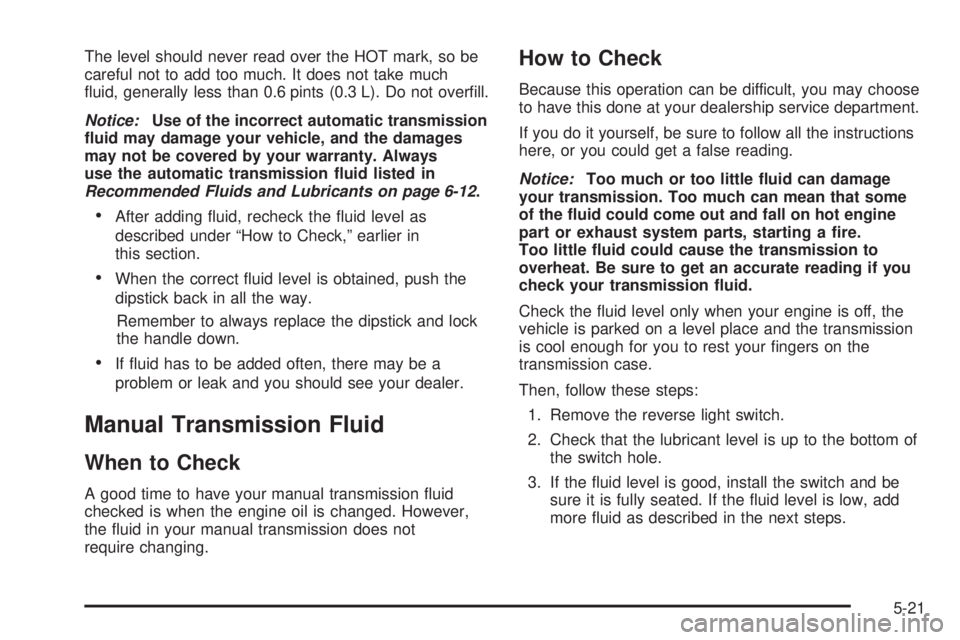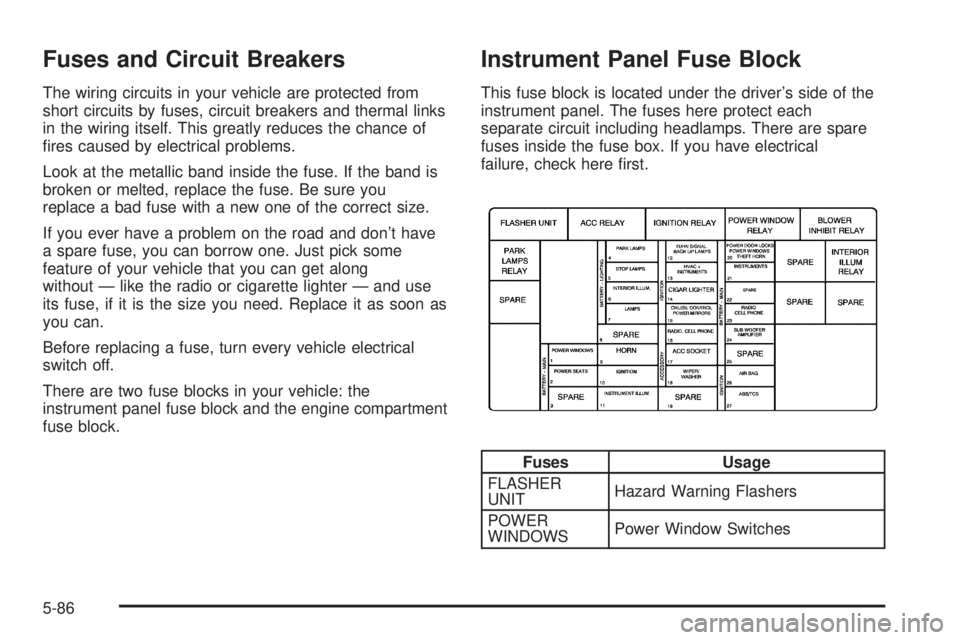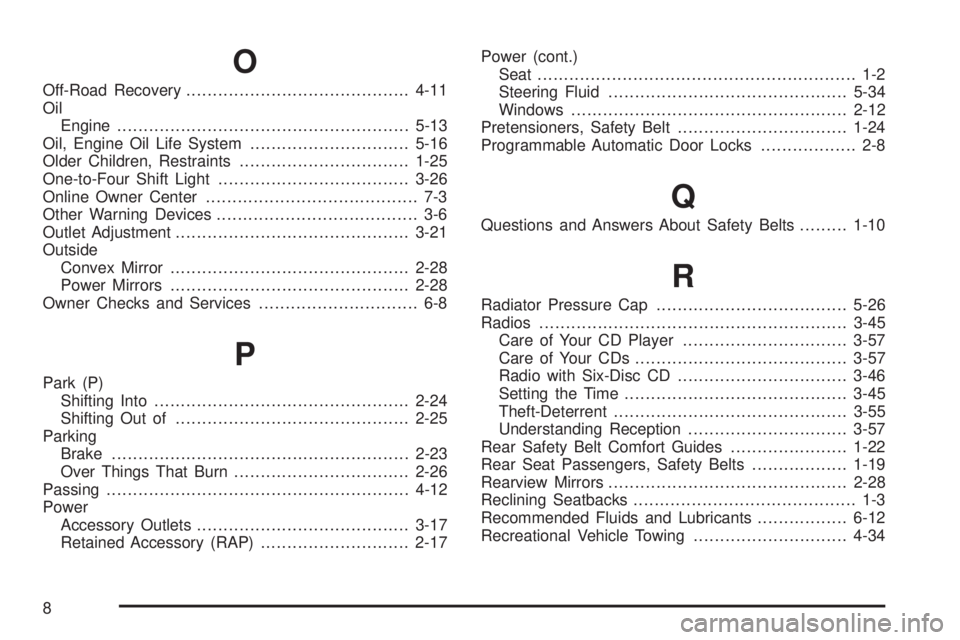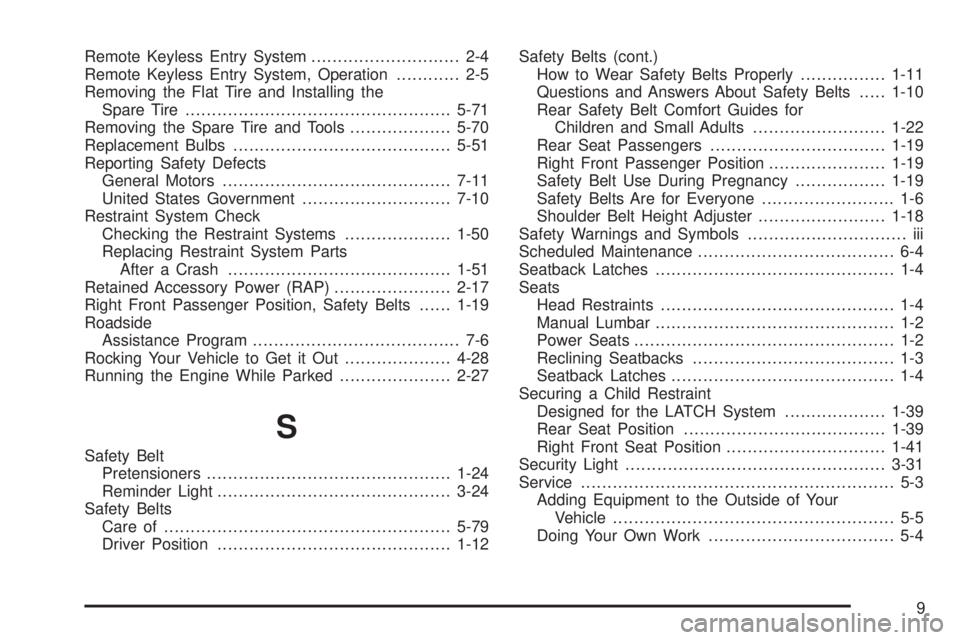check engine light PONTIAC GTO 2005 User Guide
[x] Cancel search | Manufacturer: PONTIAC, Model Year: 2005, Model line: GTO, Model: PONTIAC GTO 2005Pages: 318, PDF Size: 2.06 MB
Page 207 of 318

The level should never read over the HOT mark, so be
careful not to add too much. It does not take much
fluid, generally less than 0.6 pints (0.3 L). Do not overfill.
Notice:Use of the incorrect automatic transmission
�uid may damage your vehicle, and the damages
may not be covered by your warranty. Always
use the automatic transmission �uid listed in
Recommended Fluids and Lubricants on page 6-12.
•After adding fluid, recheck the fluid level as
described under “How to Check,” earlier in
this section.
•When the correct fluid level is obtained, push the
dipstick back in all the way.
Remember to always replace the dipstick and lock
the handle down.
•If fluid has to be added often, there may be a
problem or leak and you should see your dealer.
Manual Transmission Fluid
When to Check
A good time to have your manual transmission fluid
checked is when the engine oil is changed. However,
the fluid in your manual transmission does not
require changing.
How to Check
Because this operation can be difficult, you may choose
to have this done at your dealership service department.
If you do it yourself, be sure to follow all the instructions
here, or you could get a false reading.
Notice:Too much or too little �uid can damage
your transmission. Too much can mean that some
of the �uid could come out and fall on hot engine
part or exhaust system parts, starting a �re.
Too little �uid could cause the transmission to
overheat. Be sure to get an accurate reading if you
check your transmission �uid.
Check the fluid level only when your engine is off, the
vehicle is parked on a level place and the transmission
is cool enough for you to rest your fingers on the
transmission case.
Then, follow these steps:
1. Remove the reverse light switch.
2. Check that the lubricant level is up to the bottom of
the switch hole.
3. If the fluid level is good, install the switch and be
sure it is fully seated. If the fluid level is low, add
more fluid as described in the next steps.
5-21
Page 209 of 318

How to Check and Add Fluid
To check the fluid level, look at the markings on the
reservoir. If the fluid level is between the MIN and the
MAX line, the fluid level is correct. If the fluid level
is between these marks do not remove the cap, as the
fluid will quickly absorb moisture. SeeEngine
Compartment Overview on page 5-12for more
information on reservoir location.
If fluid does need to be added, first turn the vehicle off.
Remove the cap and add the proper fluid. Remember
to replace the cap and clean up any spilled fluid.
Engine Coolant
The cooling system in your vehicle is filled with
DEX-COOL®engine coolant. This coolant is designed
to remain in the vehicle for five years or 150,000 miles
(240 000 km), whichever occurs first, if only
DEX-COOL
®extended life coolant is added.The following explains the cooling system and how to
add coolant when it is low. If there is a problem
with engine overheating or if coolant needs to be added
to the radiator, seeEngine Overheating on page 5-26.
A 50/50 mixture of clean, drinkable water and
DEX-COOL
®coolant will:
•Give freezing protection down to−34°F (−37°C).
•Give boiling protection up to 265°F (129°C).
•Protect against rust and corrosion.
•Help keep the proper engine temperature.
•Let the warning lights and gages work as
they should.
Notice:Using coolant other than DEX-COOL
®may
cause premature engine, heater core or radiator
corrosion. In addition, the engine coolant may
require changing sooner, at 30,000 miles (50 000 km)
or 24 months, whichever occurs �rst. Any repairs
would not be covered by your warranty. Always use
DEX-COOL
®(silicate-free) coolant in your vehicle.
5-23
Page 222 of 318

Brakes
Brake Fluid
Your brake master cylinder
reservoir is filled with
DOT-4 brake fluid. See
Engine Compartment
Overview on page 5-12for
the location of the
reservoir.
There are only two reasons why the brake fluid level in
the reservoir might go down. The first is that the
brake fluid goes down to an acceptable level during
normal brake lining wear. When new linings are put in,
the fluid level goes back up. The other reason is
that fluid is leaking out of the brake system. If it is, you
should have your brake system fixed, since a leak
means that sooner or later your brakes will not work
well, or will not work at all.So, it is not a good idea to top off your brake fluid.
Adding brake fluid will not correct a leak. If you add fluid
when your linings are worn, then you will have too
much fluid when you get new brake linings. You should
add or remove brake fluid, as necessary, only when
work is done on the brake hydraulic system.
{CAUTION:
If you have too much brake �uid, it can spill on
the engine. The �uid will burn if the engine is
hot enough. You or others could be burned,
and your vehicle could be damaged. Add brake
�uid only when work is done on the brake
hydraulic system. See “Checking Brake Fluid”
in this section.
When your brake fluid falls to a low level, your brake
warning light will come on. SeeBrake System Warning
Light on page 3-27.
5-36
Page 272 of 318

Fuses and Circuit Breakers
The wiring circuits in your vehicle are protected from
short circuits by fuses, circuit breakers and thermal links
in the wiring itself. This greatly reduces the chance of
fires caused by electrical problems.
Look at the metallic band inside the fuse. If the band is
broken or melted, replace the fuse. Be sure you
replace a bad fuse with a new one of the correct size.
If you ever have a problem on the road and don’t have
a spare fuse, you can borrow one. Just pick some
feature of your vehicle that you can get along
without — like the radio or cigarette lighter — and use
its fuse, if it is the size you need. Replace it as soon as
you can.
Before replacing a fuse, turn every vehicle electrical
switch off.
There are two fuse blocks in your vehicle: the
instrument panel fuse block and the engine compartment
fuse block.
Instrument Panel Fuse Block
This fuse block is located under the driver’s side of the
instrument panel. The fuses here protect each
separate circuit including headlamps. There are spare
fuses inside the fuse box. If you have electrical
failure, check here first.
Fuses Usage
FLASHER
UNITHazard Warning Flashers
POWER
WINDOWSPower Window Switches
5-86
Page 280 of 318

Scheduled Maintenance
When the Service Engine Oil light on the trip computer
display comes on, it means that service is required
for your vehicle. SeeTrip Computer on page 3-33. Have
your vehicle serviced as soon as possible within the
next 600 miles (1 000 km). It is possible that, if you are
driving under the best conditions, the engine oil life
system may not indicate that vehicle service is
necessary for over a year. However, the engine oil
and filter must be changed at least once a year and
at this time the system must be reset. Your
GM Goodwrench
®dealer has GM-trained service
technicians who will perform this work using genuine
GM parts and reset the system.
If the engine oil life system is ever reset accidentally,
you must service your vehicle within 3,000 miles
(5 000 km) since your last service. Remember to reset
the oil life system whenever the oil is changed. See
Engine Oil Life System on page 5-16for information on
the Engine Oil Life System and resetting the system.When the Service Engine Oil light appears, certain
services, checks, and inspections are required. Required
services are described in the following for
“MaintenanceI” and “MaintenanceII.” Generally, it is
recommended that your first service be MaintenanceI,
your second service be MaintenanceII, and that you
alternate MaintenanceIand MaintenanceIIthereafter.
However, in some cases, MaintenanceIImay be
required more often.
MaintenanceI— Use MaintenanceIif the light comes
on within 10 months since the vehicle was purchased
or MaintenanceIIwas performed.
MaintenanceII— Use MaintenanceIIif the previous
service performed was MaintenanceI. Always use
MaintenanceIIwhenever the light comes on 10 months
or more since the last service or if the light has not
come on at all for one year.
6-4
Page 308 of 318

B
Backglass Antenna..........................................3-58
Battery..........................................................5-39
Run-Down Protection...................................3-16
Before Leaving on a Long Trip.........................4-20
Brake
Anti-Lock Brake System (ABS)........................ 4-6
Emergencies................................................ 4-8
Parking......................................................2-23
System Warning Light..................................3-27
Brakes..........................................................5-36
Braking........................................................... 4-5
Braking in Emergencies..................................... 4-8
Break-In, New Vehicle.....................................2-15
Bulb Replacement...........................................5-47
Front Turn Signal and Parking Lamps.............5-49
Halogen Bulbs............................................5-47
Headlamp Aiming........................................5-45
Headlamps.................................................5-47
Replacement Bulbs......................................5-51
Taillamps, Turn Signal, Stoplamps and
Back-up Lamps........................................5-50
Buying New Tires...........................................5-64
C
California Fuel.................................................. 5-6
Capacities and Specifications............................5-90
Carbon Monoxide.....................2-8, 2-26, 4-24, 4-34
Care of
Safety Belts................................................5-79
Your CD Player...........................................3-57
Your CDs ...................................................3-57
Center Console Storage Area...........................2-29
Chains, Tire...................................................5-67
Charging System Light....................................3-26
Check
Engine Light...............................................3-28
Checking Things Under the Hood......................5-10
Chemical Paint Spotting...................................5-83
Child Restraints
Child Restraint Systems...............................1-31
Infants and Young Children...........................1-28
Lower Anchorages and Top Tethers for
Children (LATCH System)..........................1-37
Older Children.............................................1-25
Securing a Child Restraint Designed for the
LATCH System........................................1-39
2
Page 310 of 318

Doing Your Own Service Work........................... 5-4
Dome Lamp...................................................3-16
Door
Locks.......................................................... 2-7
Programmable Automatic Door Locks............... 2-8
Driver
Position, Safety Belt.....................................1-12
Driving
At Night.....................................................4-14
City...........................................................4-18
Defensive..................................................... 4-2
Drunken....................................................... 4-2
Freeway.....................................................4-19
Hill and Mountain Roads..............................4-22
In Rain and on Wet Roads...........................4-16
Racing or Other Competitive Driving...............2-18
Rocking Your Vehicle to Get it Out.................4-28
Winter........................................................4-24
E
Electrical System
Add-On Equipment......................................5-85
Engine Compartment Fuse Block...................5-88
Fuses and Circuit Breakers...........................5-86
Instrument Panel Fuse Block.........................5-86Engine
Air Cleaner/Filter.........................................5-18
Battery.......................................................5-39
Check and Service Engine Soon Light............3-28
Coolant......................................................5-23
Coolant Temperature Gage...........................3-28
Engine Compartment Overview......................5-12
Exhaust.....................................................2-26
Oil .............................................................5-13
Oil Life System...........................................5-16
Overheating................................................5-26
Racing or Other Competitive Driving...............2-18
Starting......................................................2-17
Entry Lighting.................................................3-16
Event Data Recorders (EDR)............................. 7-9
Exterior Lamps...............................................3-13
F
Filter
Engine Air Cleaner......................................5-18
Finish Damage...............................................5-82
Flash-to-Pass................................................... 3-9
Flat Tire........................................................5-68
Flat Tire, Changing.........................................5-68
Flat Tire, Storing.............................................5-75
4
Page 314 of 318

O
Off-Road Recovery..........................................4-11
Oil
Engine.......................................................5-13
Oil, Engine Oil Life System..............................5-16
Older Children, Restraints................................1-25
One-to-Four Shift Light....................................3-26
Online Owner Center........................................ 7-3
Other Warning Devices...................................... 3-6
Outlet Adjustment............................................3-21
Outside
Convex Mirror.............................................2-28
Power Mirrors.............................................2-28
Owner Checks and Services.............................. 6-8
P
Park (P)
Shifting Into................................................2-24
Shifting Out of............................................2-25
Parking
Brake........................................................2-23
Over Things That Burn.................................2-26
Passing.........................................................4-12
Power
Accessory Outlets........................................3-17
Retained Accessory (RAP)............................2-17Power (cont.)
Seat............................................................ 1-2
Steering Fluid.............................................5-34
Windows....................................................2-12
Pretensioners, Safety Belt................................1-24
Programmable Automatic Door Locks.................. 2-8
Q
Questions and Answers About Safety Belts.........1-10
R
Radiator Pressure Cap....................................5-26
Radios..........................................................3-45
Care of Your CD Player...............................3-57
Care of Your CDs........................................3-57
Radio with Six-Disc CD................................3-46
Setting the Time..........................................3-45
Theft-Deterrent............................................3-55
Understanding Reception..............................3-57
Rear Safety Belt Comfort Guides......................1-22
Rear Seat Passengers, Safety Belts..................1-19
Rearview Mirrors.............................................2-28
Reclining Seatbacks.......................................... 1-3
Recommended Fluids and Lubricants.................6-12
Recreational Vehicle Towing.............................4-34
8
Page 315 of 318

Remote Keyless Entry System............................ 2-4
Remote Keyless Entry System, Operation............ 2-5
Removing the Flat Tire and Installing the
Spare Tire..................................................5-71
Removing the Spare Tire and Tools...................5-70
Replacement Bulbs.........................................5-51
Reporting Safety Defects
General Motors...........................................7-11
United States Government............................7-10
Restraint System Check
Checking the Restraint Systems....................1-50
Replacing Restraint System Parts
After a Crash..........................................1-51
Retained Accessory Power (RAP)......................2-17
Right Front Passenger Position, Safety Belts......1-19
Roadside
Assistance Program....................................... 7-6
Rocking Your Vehicle to Get it Out....................4-28
Running the Engine While Parked.....................2-27
S
Safety Belt
Pretensioners..............................................1-24
Reminder Light............................................3-24
Safety Belts
Care of......................................................5-79
Driver Position............................................1-12Safety Belts (cont.)
How to Wear Safety Belts Properly................1-11
Questions and Answers About Safety Belts.....1-10
Rear Safety Belt Comfort Guides for
Children and Small Adults.........................1-22
Rear Seat Passengers.................................1-19
Right Front Passenger Position......................1-19
Safety Belt Use During Pregnancy.................1-19
Safety Belts Are for Everyone......................... 1-6
Shoulder Belt Height Adjuster........................1-18
Safety Warnings and Symbols.............................. iii
Scheduled Maintenance..................................... 6-4
Seatback Latches............................................. 1-4
Seats
Head Restraints............................................ 1-4
Manual Lumbar............................................. 1-2
Power Seats................................................. 1-2
Reclining Seatbacks...................................... 1-3
Seatback Latches.......................................... 1-4
Securing a Child Restraint
Designed for the LATCH System...................1-39
Rear Seat Position......................................1-39
Right Front Seat Position..............................1-41
Security Light.................................................3-31
Service........................................................... 5-3
Adding Equipment to the Outside of Your
Vehicle..................................................... 5-5
Doing Your Own Work................................... 5-4
9